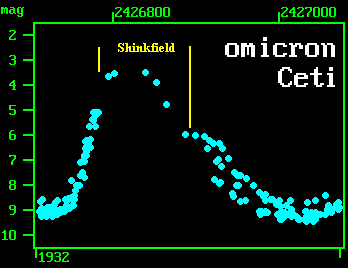
On 1997 April 16th Taiki Kato noted on VSNET that the Northern observing season of Mira (omicron Ceti) had ended with a relatively bright maximum and asked if Southern observers could follow the star closer to solar conjunction. This brought a series of electronic messages on the subject from all over the world. (A 'thread' in internet language.) Mira is perhaps the most famous variable being discovered in 1596 by David Fabricius in Germany, the first observed maximum was June 25th of that year.
Kato's message was No 221 in 'vsnet-chat' - an extra section then recently started for informal discussion of variable stars. In No 226, Stan Walker (New Zealand) noted that Mira is practically equatorial at -3 degrees declination, whereas the current RASNZ programmes concentrate on objects south of -30deg. Kato responded [228] with a list of japanese observations before and after the last 20 conjunctions and Walker [230] tried extracting similar southern observations for comparison. Fraser Farrell (South Australia) commented [233] that most southern observers probably nowadays mostly follow far south eruptive variables which cannot be seen from northern latitudes.
Bjorn Granslo (Norway) pointed out [241] that the celestial latitude of Mira, -16deg, was more important than declination. He gave calculated figures for theoretical visibility from latitudes +82 to -88 with an optimum at -54.5. Emile Schweitzer (France) presented tables of seasonal visibility of Mira observations from the AFOEV database [255], together with names and locations of the observers. Farrell noted [258] that there was not much land surface at -54.5 latitude, and probably not many clear skies either! Charles Scovil (USA) said [161] that the AAVSO had a very long series of observations in electronic format from which maxima back over 130 years had been published in a book by Leo Campbell.
In the meantime, I had checked that our BAAVSS database only needed a dozen
more years for completing the Mira record from 1905 to the present. Phil
Barnard was already working on the 1925-1929 memoirs so I asked if he might
do Mira next while I tackled 1930-34 plus other remaining years. This was
done, a program written to extract observations adjacent to conjunction, and
the results posted to VSNET on 26 Apr [265]. Although Northern observers
naturally had last/first observations in recent decades, the early published
memoirs contained results from all over the world.
The two observations in our database closest to conjunction were;
latest... 1913 Apr 15 C J Westland New Zealand earliest... 1932 May 11 R C Shinkfield South AustraliaGiving a possible minimum gap of 26 days.
There were a couple more exchanges in regard to AAVSO data and then Fraser Farrell posted May 2nd [276];
" G'day Dave (and vsnetters...), And here are the full details of that early observation from the late Reg Shinkfield's actual notebook: 1932 May 12 05:35 local time (UT+9.5hours) 1932 May 11 08:05 GMT (=UT) JD 2426839. instrument = binoculars (I think Reg used 8x42s ?) mag 3.5 sky = 1 (good) class = 1 (good) Reg's written comment is "low". He was observing from home (inner suburb of Adelaide) during an era when the streetlights were turned off after midnight. Adelaide had a population well below 300,000 in those days; the high cost of electricity and the stringencies of the Depression would have kept early morning light pollution well down. According to GUIDE 5.1, Mira was at an altitude of 6.1 degrees and azimuth of 89.7 degrees. The corresponding values for the Sun are -17.7 and 80.1 degrees, so Mira was above the Sun in an almost astronomically dark sky. However, local geography - the Adelaide Hills - would have helped darken the sky a bit more. From Reg Shinkfield's suburb they dominate the eastern view and rise to an average 4-5 degrees above the theoretical horizon. A maximum at the time of conjunction definitely helped, but having a 600 metre high wall of rock to hide the rising Sun for those few extra moments seems to make the difference! An opportunity exists to beat Reg's record during the next couple of weeks - when a bright Mira emerges from conjunction. Those of you who have a well-positioned mountain to the east are favoured to win this contest (go for it, Michael! :) cheers, Fraser Farrell "
| I did not hear if anyone took up Fraser's challenge. Mira's period of around 332 days means that the phase advances each year so the next opportunity of a maximum occurring near conjunction will be 2006 or 2007. |  |
The VSNET mail archive index can be accessed at:
http://www.kusastro.kyoto-u.ac.jp/vsnet/Mail/index.html
and individual messages mentioned above at;
http://www.kusastro.kyoto-u.ac.jp/vsnet/Mail/vsnet-chat/msgNNNNN.html
where NNNNN represents the sequential number (e.g. 00221).
OR by ftp at; ftp://ftp.kusastro.kyoto-u.ac.jp/pub/vsnet/Mail